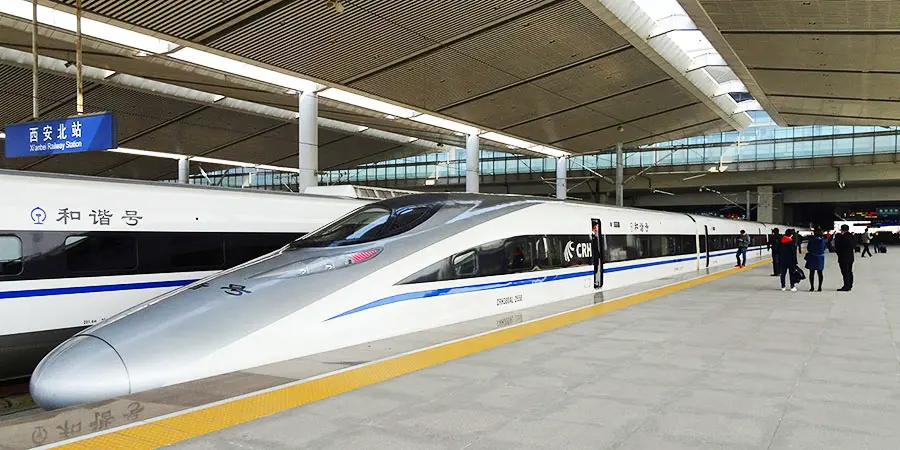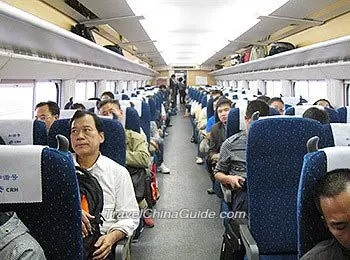http://book.huochepiao.com/
http://www.travelchinaguide.com/china-trains/high-speed/
xiamen to shenzhen high spd train
 |
High-speed
trains (G, D, C trains in China) run much faster than the normal ones.
As well as traveling at speeds of upto 400km/h, the bullet trains are
operated by advanced technological communication systems.
China is a vast country, covering almost 10 million square km (about 3.9 million square mi), with the distance of 5,500 km (about 3,417 mi) in north-south direction and 5,200 km (about 3,231 mi) in east-west direction. On the standard rail network, it can take a long time to reach your destination. For instance from Beijing to Guangzhou, a distance of over 2,000 km (about 1,243 mi), it takes nearly 24 hours, however, the journey time is cut to just 8 hours by bullet train. China has so many worthy destinations, many of which are far apart from one to another, and in most cases, tourists have no choice but to take an airplane. So to solve the problem, China has developed the high-speed rail network to cover more of the country, making long-distance trips more convenient, time-saving and feasible.
Now people generally prefer to travel by high-speed trains, which should be attributed to its advantages:
China is a vast country, covering almost 10 million square km (about 3.9 million square mi), with the distance of 5,500 km (about 3,417 mi) in north-south direction and 5,200 km (about 3,231 mi) in east-west direction. On the standard rail network, it can take a long time to reach your destination. For instance from Beijing to Guangzhou, a distance of over 2,000 km (about 1,243 mi), it takes nearly 24 hours, however, the journey time is cut to just 8 hours by bullet train. China has so many worthy destinations, many of which are far apart from one to another, and in most cases, tourists have no choice but to take an airplane. So to solve the problem, China has developed the high-speed rail network to cover more of the country, making long-distance trips more convenient, time-saving and feasible.
Now people generally prefer to travel by high-speed trains, which should be attributed to its advantages:
1. Fast: The present speed is higher than 200km/h, lessening the journey duration. For example, from Beijing to Shanghai, a distance of over 1,200 km (about 746 mi), it takes around 15 hours by normal trains, but the bullet trains just need 5 hours.
2. Punctual: Less influence by weather, they usually arrive at their destinations on time. By contrast, a bus may be delayed because of traffic jams or bad road conditions. Flights may be cancelled because for the bad weather.
3. Comfortable and Convenient: Seating is very comfortable, and the facilities can better meet passengers’ demands. Bullet trains are scheduled more frequently for many journeys so that passengers don’t need to wait too long.
High-speed trains also overcome the disadvantages of buses which face severe safety problems especially for those overnight ones. On the other hand, considering the airports which are usually located far from the city center and the long procedure for taking a flight, travel by the bullet train can be more time-saving and convenient, especially for a journey within 5 hours.
 |
Seats are divided into second-class, first-class, business-class, super-class, and sightseeing seats.
Facilities on these highballs bring much convenience for passengers. It is possible for passengers to use power points and Wi-Fi (Wireless Fidelity). In addition, dining, left-luggage and toilets will never be problems.
Development and Current Railway NetworkSince the earliest high-speed rail line - Qinhuangdao-Shenyang Passenger Transport Special Line was constructed in 1999, China has developed a widely-used railway network. By the end of 2011, the railway network with the speed of higher than 200km/h covered 10,000 km (about 6,214 mi). By the end of 2012, China had achieved the “Four North-South and Four East-West Network”. At the same time, the intercity high-speed railways also provide much convenience. The total length of such railway is expected to reach around 13,000 km (about 8,078 mi). According to the long-term extension plan, China will own 50,000 km (about 31,068 mi) high-speed railway by 2020.
Line
|
Open Date
|
Length (km)
|
Speed (km/h)
| |
Four North-South High-speed Rail Lines
| ||||
--
|
1318
|
--
| ||
Beijing-Shanghai High-Speed Railway (Jinghu Line)
|
2011/06/30
|
1318
|
300
| |
Hefei-Bengbu (Hebeng) Line
|
2012/10/16
|
131
|
350
| |
(Beijing-Guangzhou High-Speed Railway in operation since 2012) |
--
|
2360
|
--
| |
Beijing-Shijiazhuang (Jingshi) Line
|
2012/12/26
|
281
|
350
| |
Shijiazhuang-Wuhan (Shiwu) Line
|
2012/12/26
|
841
|
350
| |
Wuhan-Guangzhou (Wuguang) Line
|
2009/12/26
|
1069
|
300
| |
Guangzhou-Shenzhen-Hong Kong Railway
(Guangshengang Line) |
Guangzhou – Shenzhen: 2011/12/26;
Shenzhen – Kowloon: 2015 |
142
|
350;
Shenzhen – Kowloon: 200 | |
--
|
1700
|
--
| ||
Beijing-Shenyang (Jingshen) Line
|
2014
|
709
|
350
| |
Harbin-Dalian (Hada) Line
|
2012/12/01
|
921
|
300
| |
Panjin-Yingkou (Panying) Line
|
2013/09/12
|
89
|
350
| |
--
|
1450
|
--
| ||
Hangzhou-Ningbo (Hangyong) Line
|
2013/07/01
|
150
|
350
| |
Ningbo-Taizhou-Wenzhou (Yongtaiwen) Line
|
2009/09/28
|
268
|
200
| |
Wenzhou-Fuzhou (Wenfu) Line
|
2009/06/30
|
298
|
200
| |
Fuzhou-Xiamen (Fuxia) Line
|
2010/04/26
|
273
|
250
| |
Xiamen-Shenzhen (Xiashen) Line
|
2013/12/28
|
502
|
200
| |
Four East-West High-speed Rail Lines
| ||||
--
|
1400
|
--
| ||
Zhengzhou-Xuzhou (Zhengxu) Line
|
2016
|
361
|
350
| |
Zhengzhou-Xian (Zhengxi) Line
|
2010/02/06
|
505
|
300
| |
Xian-Baoji (Xibao) Line
|
2013/12/28
|
138
|
250
| |
Baoji-Lanzhou (Baolan) Line
|
2017
|
403
|
250
| |
--
|
2264
|
--
| ||
Shanghai-Hangzhou (Huhang) Intercity Line
|
2010/10/26
|
159
|
300
| |
Hangzhou-Changsha (Hangchang) Line
|
2014
|
927
|
350
| |
Changsha-Kunming (Changkun) Line
|
2016
|
1175
|
350
| |
--
|
770
|
--
| ||
Qingdao-Jinan (Jiaoji) Line
|
2008/12/20
|
362
|
250
| |
Shijiazhuang-Taiyuan (Shitai) Line
|
2009/04/01
|
225
|
250
| |
Shijiazhuang-Jinan (Shiji) Line
|
2015/12
|
319
|
250
| |
--
|
2078
|
--
| ||
Shanghai-Nanjing (Huning) Line
|
2010/07/01
|
301
|
300
| |
Hefei-Nanjing (Hening) Line
|
2008/04/18
|
166
|
250
| |
Hefei-Wuhan (Hewu) Line
|
2009/04/01
|
359
|
250
| |
Wuhan-Yichang (Hanyi) Line
|
2012/07/01
|
291
|
200
| |
Yichang-Wanzhou (Yiwan) Line
|
2010/12/22
|
377
|
160
| |
Chongqing-Lichuan (Yuli) Line
|
2013/12/28
|
264
|
200
| |
Suining-Chongqing (Suiyu) Line
|
2012
|
131
|
200
| |
Dazhou-Chengdu (Dacheng) Line
|
2009/07/07
|
374
|
160
| |
Line
|
Open Date
|
Length (km)
|
Designed Speed (km/h)
|
Qinhuangdao-Shenyang (Qinshen)
|
2003/10/12
|
404
|
200
|
Beijing-Tianjin (Jingjin)
|
2008/08/01
|
119
|
350
|
Chengdu-Dujiangyan (Chengguan)
|
2010/05/10
|
68
|
200
|
Nanchang-Jiujiang (Changjiu)
|
2010/09/20
|
135
|
250
|
Changchun-Jilin (Changji)
|
2011/01/11
|
108
|
250
|
Hainan Eastern Ring Railway
|
2010/12/30
|
308
|
250
|
Guangzhou-Zhuhai (Guangzhu)
|
2012/12/31
|
117
|
200
|
Guangzhou-Shenzhen (Guangshen)
|
2011/12/26
|
116
|
350
|
Shanghai-Nanjing (Huning)
|
2010/07/01
|
301
|
350
|
Nanjing-Hangzhou (Ninghang)
|
2013/07/01
|
249
|
350
|
Tianjin-Qinhuangdao (Jinqin)
|
2013/12/01
|
261
|
300
|
No comments:
Post a Comment